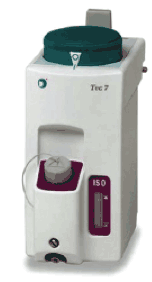Numerous questions to the Committee on Technology are individually and quickly answered each quarter by knowledgeable committee members. Many of those responses would be of value to the general readership, but are not suitable for the Dear SIRS column. Therefore, we have created this simple column to address the needs of our readership.
 Dear Q&A,
Dear Q&A,
We have a new GE Datex-Ohmeda Aestiva/5 anesthesia machine. The isoflurane Tec 7 vaporizer has a concentration dial in turquoise, but a purple color patch near the filling spout (see photo insert). Isoflurane bottles are, of course, purple. The sevoflurane Tec 7 vaporizer has its dial also in turquoise, but a yellow color patch near the filling spout. Sevoflurane bottles are, of course, yellow.
Since their introduction to the GE market, sevoflurane Tec 7 vaporizers have always had a distinguishing turquoise dial. For me, seeing this same color dial now on the isoflurane vaporizer is very confusing. I surmise that these turquoise colored dials are due to color aesthetics (the GE Datex-Omeda logo is turquoise).
To avoid this confusion, it seems reasonable for isoflurane vaporizers to have a purple dial, and for sevoflurane vaporizers to have a yellow dial. This would avoid volatile anesthetic color-coded confusion.
Sincerely,
Heddy-Dale Matthias, MD
Madison, MS
 Dear Dr. Matthias,
Dear Dr. Matthias,

The GE Healthcare, formerly Datex-Ohmeda Tec 7 Vaporizer with teal concentration dial and agent-specific color coding near the agent filler and sight glass areas. Photo courtesy of GE Healthcare, with permission.
When designing the Tec 7 vaporizer, we recognized the need for easier identification of drug variant as compared to the Tec 5 vaporizer, which only had a very small label on the front cover. Given that goal, we added the agent color along with a generic drug reference to the sight glass area and agent color reference surrounding the agent filler areas. In clinical tests conducted at a major medical center in Chicago, clinicians were easily able to identify the agent variant from across the room (from one corner of the OR to the other).
When determining what color the dial strip and agent concentration dial should be, we chose the teal green for several reasons. One would be for the Datex-Ohmeda branding guidelines, but the other was for a clinician therapy reference. Under Datex-Ohmeda design guidelines, all clinical therapy touch points were teal green. This color plan appeared on ventilator control knobs and monitor control knobs and was carried onto the vaporizer concentration dial. The idea was that clinician therapy-related touch points would appear in this teal green color. If you recall on the Tec 5 and older vaporizers, the concentration dial and dial strip were black.
From a quality and customer feedback standpoint, we have received no complaints on the Tec 5 variants with the black agent concentration dial or on the Tec 7 with the teal agent concentration dials reflecting inability to identify vaporizer agent variant.
I hope this explanation helps.
Jane Gilbertson
Global Product Manager
GE Healthcare, formerly Datex-Ohmeda
 Dear Dr. Matthias,
Dear Dr. Matthias,
ECRI has never heard of a similar complaint, and no reports are listed in our databases. We tend to agree with those whose responses can be summarized as, “It doesn’t seem like a significant problem.” Teal/turquoise is the color that Datex-Ohmeda uses in a few places on its otherwise off-white anesthesia units. The D-O response indicates that this color identifies controls that the user would adjust or touch, and while we’ve seen no discussion measuring the effectiveness of the approach, we’ve never considered it particularly harmful. The fact is that the color in question isn’t related to any existing agent, so we’re puzzled that one would make such an association. The standard color-coding is still displayed prominently on the face of the vaporizer, and that’s long been a method of identification. Additionally, with any medical gas, the color is one indicator but the definitive indicator is the label; we think similar thinking applies here. The position of the vaporizer on the anesthesia machine puts the agent color indicators and labeling at about at eye level and the teal adjusting knob above eye level making it less likely to confuse the agent and the adjustment. This is reasonable human factors design. Finally, although refilling errors (i.e., filling a vaporizer with the incorrect agent) occur on occasion, we believe that the current scheme of unique connectors, color indicators, and labeling makes an error unlikely even if the user initially mistakes the teal dial as representing a particular agent. The vaporizer picture below is worth a thousand words and might be useful in the newsletter in explaining this question.
Albert L. de Richemond, MS, PE
Associate Director
Accident and Forensic Investigation Group
ECRI, a non-profit health services research organization
5200 Butler Pike
Plymouth Meeting, PA 19462-1298
The information provided in this column is for safety-related educational purposes only, and does not constitute medical nor legal advice. Individual or group responses are only commentary, provided for purposes of education or discussion, and are neither statements of advice nor the opinions of APSF. It is not the intention of APSF to provide specific medical or legal advice or to endorse any specific views or recommendations in response to the inquiries posted. In no event shall APSF be responsible or liable, directly or indirectly, for any damage or loss caused or alleged to be caused by or in connection with the reliance on any such information.


 Issue PDF
Issue PDF